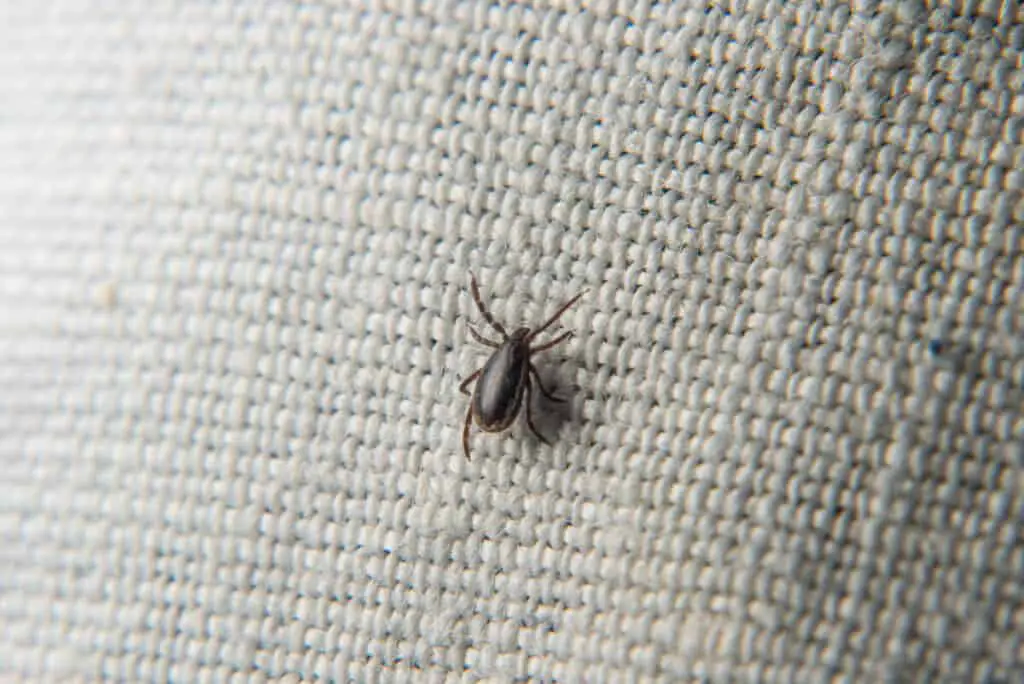Affiliate Disclosure: This post may contain affiliate links. If you make a purchase after clicking on these links I will be compensated at no extra cost to you. However, I never recommend anything I don’t love or wouldn’t use myself!
Ticks are pesky little parasites that bury their heads into their host’s skin and proceed to feed off of their blood. Seeing as these tiny arthropods are so small and inconspicuous, sometimes it’s not so obvious that your dog may have picked one up.
Ticks can cause some serious health implications for your four-legged friend and can transmit some nasty diseases such as Lyme disease, so it’s important to identify if and when your dog might have one.
Signs That Your Dog May Have Ticks:
There are several signs to look out for or behaviors that your dog may exhibit if they have ticks. Here is a list that you should be aware of.
1. Ticks or Eggs in Your Home or Backyard
If you come across a lone tick or a cluster of tick eggs in your home or garden then there is a good chance your dog may be harboring some additional “friends.”


Ticks or their eggs inside the home are usually found in areas such as carpets, furniture, bedding, and clothing. If you spot any, be sure to give your dog a once-over.
2. Small Bumps on Your Dog’s Skin
When running your hands through your dog’s coat, if you come across any small but firm bumps you should inspect them closer to rule out the presence of a tick.
Ticks may have a similar appearance to a wart or skin tag but while warts and skin tags are usually closer to your dog’s natural skin shade, ticks usually differ in color.
upon further inspection, you should also be able to see some legs towards the head of the tick which will be buried into your dog’s skin. They may also move their legs if you touch them.
Ticks usually embed themselves in hard-to-reach, warm areas on your dog. They are often found in places such as the ears, neck, armpits, groin, or between the toes, so check these areas thoroughly.
3. Your Dog Shows Signs of Itchiness, Scabs, or Sores
As with fleas, ticks bites can aggravate your dog’s skin and cause itchiness. This leads to excessive licking, biting, or scratching from your dog which can lead to scabs and sores on their skin.
Sometimes your dog may have removed the main body of the tick which may leave a sore patch of skin. It’s important to check these sores more closely as often the jaws of the tick may be left buried into the skin.
A tick that has not been properly removed can lead to infection so be sure to fully remove any remnants and clean the wound thoroughly with antiseptic. You should also monitor the sore patch over the coming days.
4. Your Dog Is Shaking Its Head Excessively
As ticks love to find warmer harder to reach areas on your dog, this often leads them towards your dog’s ears, and possibly even into the ear canal itself.

As you can imagine, this is extremely unpleasant for your dog and will often cause them to shake their heads frequently as they try to shake the tick free.
5. Your Dog Has Difficulty Walking
As the tick’s saliva makes its way into your dog’s bloodstream it can have a number of negative effects on your dog that are not too dissimilar from that of a venomous snake bite. One of these effects is paralysis.
Initial effects of tick paralysis usually begin in the hind legs and then work their way forward to the front legs and so on.
This may become noticeable as your dog becomes wobbly and uncoordinated as they try to walk.
6. Your Dog Has Problems With Eating
Dogs suffering the effects of tick bites may have difficulty when eating their food, often struggling to swallow properly.
This puts them at great risk of choking and aspiration which can lead to pneumonia and other serious problems.
If your dog is showing evidence of these symptoms, take them to a vet immediately.
7. Your Dog Has a Fever
Fever can be the result of many illnesses and ailments but if you’re unsure of the cause, it’s worth checking them over for ticks.
Some signs that your dog has a fever are, red or glazed over eyes, hot ears, a hot nose, loss of appetite, weakness, shivering, or unexplained panting.
8. Your Dog Is Coughing or Struggling to Breathe
Tick paralysis can weaken respiratory muscles and dogs may struggle to breathe. This can also cause them to inhale saliva and make them cough.
Inhaling too much saliva can also lead to pneumonia. You should not hesitate to take them straight to the vet if they display these symptoms
9. Your Dog Is Unable to Sit or Stand
As paralysis takes hold it can start to affect all of your dog’s muscles. Your dog may also feel weak and lethargic in general and will feel the need to lay down.
Particularly if you see your dog laying on its side in conjunction with some of the above-listed symptoms you shouldn’t hesitate to contact your vet.
What to Do if Your Dog Has Ticks?

If you find ticks on your dog you should try to remove them as soon as possible. This can usually be done safely at home with the use of a good tick removal tool (Amazon). I really recommend this type of dual-pronged tool as the safest most reliable way to remove a tick.
When using tweezers, and other tools that use a pincer-type motion to grasp onto the tick, you will need to take extra care. If you squeeze or rupture the tick’s abdomen it can cause additional toxins to be released back into your dog. This can result in additional problems and infections.
How to remove a tick from your dog:
- Grasp the tick by the head, as close to your dog’s skin as possible, and pull firmly and persistently at a straight angle away from your dog’s skin, avoiding any jerking motions. Take your time and encourage the tick to let go naturally.
- Once removed, you can place the tick in Isopropyl alcohol to kill it. You can also keep hold of it and give it to your vet for further inspection in case your dog has any further complications.
- Clean the affected area on your dog with antiseptic and monitor the bite site for any signs of infection over the coming days.
Precautions when removing a tick from your dog:
- When trying to remove a tick, I would advise not to smother it in chemicals. This may result in the tick releasing toxins into your dog’s body.
- Many sources recommend using a twisting motion when removing a tick but in my experience, this often results in breaking the tick’s mandibles off and causing further complications.
When to Contact the Vet
If your dog displays any of the more severe symptoms mentioned in this article, such as fever, problems with mobility, eating, or breathing then you should contact your vet immediately.

